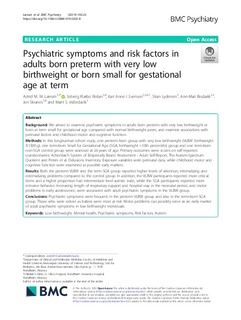| dc.contributor.author | Lærum, Astrid Merete Winsnes | |
| dc.contributor.author | Reitan, Solveig Merete Klæbo | |
| dc.contributor.author | Evensen, Kari Anne Indredavik | |
| dc.contributor.author | Lydersen, Stian | |
| dc.contributor.author | Brubakk, Ann-Mari | |
| dc.contributor.author | Skranes, Jon Sverre | |
| dc.contributor.author | Indredavik, Marit Sæbø | |
| dc.date.accessioned | 2019-07-22T07:58:35Z | |
| dc.date.available | 2019-07-22T07:58:35Z | |
| dc.date.created | 2019-07-19T13:58:10Z | |
| dc.date.issued | 2019 | |
| dc.identifier.citation | BMC Psychiatry. 2019, 19 (223) | nb_NO |
| dc.identifier.issn | 1471-244X | |
| dc.identifier.uri | http://hdl.handle.net/11250/2606076 | |
| dc.description.abstract | Background
We aimed to examine psychiatric symptoms in adults born preterm with very low birthweight or born at term small for gestational age compared with normal birthweight peers, and examine associations with perinatal factors and childhood motor and cognitive function.
Methods
In this longitudinal cohort study, one preterm born group with very low birthweight (VLBW: birthweight ≤1500 g), one term-born Small for Gestational Age (SGA: birthweight <10th percentile) group and one term-born non-SGA control group, were assessed at 26 years of age. Primary outcomes were scores on self-reported questionnaires: Achenbach System of Empirically Based Assessment - Adult Self-Report, The Autism-Spectrum Quotient and Peters et al. Delusions Inventory. Exposure variables were perinatal data, while childhood motor and cognitive function were examined as possible early markers.
Results
Both the preterm VLBW and the term SGA group reported higher levels of attention, internalizing and externalizing problems compared to the control group. In addition, the VLBW participants reported more critical items and a higher proportion had intermediate level autistic traits, while the SGA participants reported more intrusive behavior. Increasing length of respiratory support and hospital stay in the neonatal period, and motor problems in early adolescence, were associated with adult psychiatric symptoms in the VLBW group.
Conclusions
Psychiatric symptoms were frequent in the preterm VLBW group and also in the term-born SGA group. Those who were sickest as babies were most at risk. Motor problems can possibly serve as an early marker of adult psychiatric symptoms in low birthweight individuals. | nb_NO |
| dc.language.iso | eng | nb_NO |
| dc.publisher | BioMed Central | nb_NO |
| dc.rights | Navngivelse 4.0 Internasjonal | * |
| dc.rights.uri | http://creativecommons.org/licenses/by/4.0/deed.no | * |
| dc.title | Psychiatric Symptoms and Risk Factors in Adults Born Preterm with Very Low Birthweight or Born Small for Gestational Age at Term | nb_NO |
| dc.type | Journal article | nb_NO |
| dc.type | Peer reviewed | nb_NO |
| dc.description.version | publishedVersion | nb_NO |
| dc.source.volume | 19 | nb_NO |
| dc.source.journal | BMC Psychiatry | nb_NO |
| dc.source.issue | 223 | nb_NO |
| dc.identifier.doi | 10.1186/s12888-019-2202-8 | |
| dc.identifier.cristin | 1712133 | |
| dc.description.localcode | Open Access This article is distributed under the terms of the Creative Commons Attribution 4.0 International License (http://creativecommons.org/licenses/by/4.0/), which permits unrestricted use, distribution, and reproduction in any medium, provided you give appropriate credit to the original author(s) and the source, provide a link to the Creative Commons license, and indicate if changes were made. | nb_NO |
| cristin.unitcode | 194,65,15,0 | |
| cristin.unitcode | 194,65,35,0 | |
| cristin.unitcode | 194,65,35,5 | |
| cristin.unitname | Institutt for klinisk og molekylær medisin | |
| cristin.unitname | Institutt for psykisk helse | |
| cristin.unitname | RKBU Midt-Norge - Regionalt kunnskapssenter for barn og unge - psykisk helse og barnevern | |
| cristin.ispublished | true | |
| cristin.fulltext | original | |
| cristin.qualitycode | 1 | |

